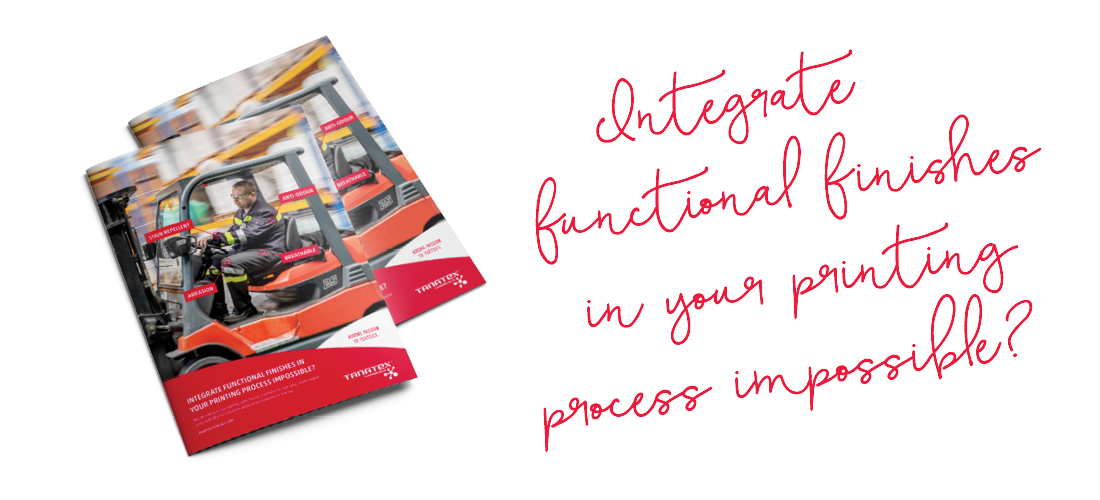Printing functional finishes
Madelaine Cornforth talks to Thomas Ruchser, Global Manager of Digital Printing and Carpet Solutions about the company’s developments in functional inks and finishing.
Today there are textile finishes for almost every challenge thinkable. Hydrophobic, anti-microbial and flame-retardant finishes are among some of the most popular for the apparel, home textiles and soft signage industries. For example, functional finishes such as these can be added to clothes to make the wearer feel more comfortable and to keep them dry. Furthermore, other finishes soften bed linen, make tent canvases flame-retardant or protect upholstery from damaging. However, TANATEX asks the question: “How do you apply them to specific parts of your textiles in one run?”. For this reason TANATEX experts are working on the answer. As a result, a promising chemical solution isfound to integrate functionalised finishes by digital (valve jet) printing on to fabric, according to TANATEX.
Valve jet printing
In valve jet printing, the print head nozzles fit with individual valves. Therefore, they can open or close as an ink drop is required. “We have developed a jettable compound as basis for applications,” says Thomas Ruchser. “It guarantees a smooth run ability of valve jet for hours. You just mix the compound with water and add the needed chemicals to achieve functionality.”
The company decided that valve jet, rather than inkjet was the best technology to provide a solution to only printing in certain areas. This was due to the technology’s flexible pick-up being higher than inkjet. Additionally, with valve jet, ‘existing standard chemicals can be applied.’ Thus there is no need to create new ones for already available finishes, says Ruchser.
At the bottom of this page, you can find a simple guide to see if integrating functional finishes in your printing process is possible.
Printing requirements for functional finishes
Ultimately, functional finishes need to meet several requirements for printing. Ruchser notes that these are:
- Rheology suitable for jetting (shear thinning property)
- No drying during jetting and over run length
- Variable viscosity, depending on requirements
Advantages of ‘functionalised inks’
There are many advantages of using ‘functionalised inks’ for valve jet printing to finish certain areas of a textile to give it added function. Ruchser says: “Digital textile printing creates ultimate flexibility. As a result, textile manufacturers can print all imaginable patterns on textiles, independently of repeating patterns. You can produce countless designs without chemicals and fabric wastage.
“Moreover, the adjustment of the printing system and the alignment of the printing templates that are so time-consuming have become a thing of the past. Imagine the flexibility a user will have in applying several functionalities on a selected part of the fabric, or integrated in the design,” Ruchser continues.
These would all be done in the same run or personalised for specific customers. “Consequently, this saves a lot of time. But it also considerably reduces the consumption of water and chemicals and the contamination of wastewater,” says Ruchser.
Possible applications
Other possible applications include medical, technical or home textiles, such as:
- Thermal effects (cooling, heating)
- Moisture management (water/oil repellence, hydrophilic effects)
- Odour control
- Antibacterial
- Anti-slip
- Anti-crease
- Conductivity
- Optical effects
Scented finishing
TANATEX has worked on is ‘functionalised inks’. The company’s BAYSCENT® range consists of different scents. The possibilities are endless when it comes to application. For example, you can add lavender scent on bed linen. But also lemon on the textiles of a car seat to work as an air-freshener in the car. Ruchser explains: “Applications would be similar to regular finishing applications via foulard. The advantage is that the finish only needs to be applied on one side and only where needed.” TANATEX uses Zimmer Austria’s Chromojet technology to apply the inks. “We felt it should be possible as well to add functionalised finished via valve jet printing onto textiles,” says Ruchser. “So, next to the known printing process utilising colour, we apply a functionality onto the textiles where needed. For example, anti-odour finishes for the armpits, or every scent you can think of (a separate finish, not an ink).”
Thomas Ruchser,
Global Manager of Digital Printing and Carpet Solutions







